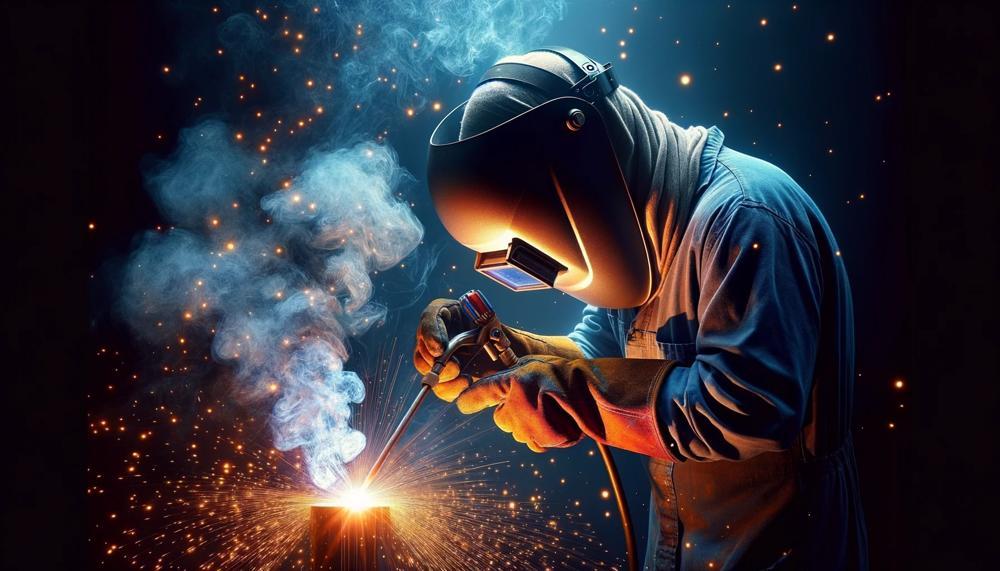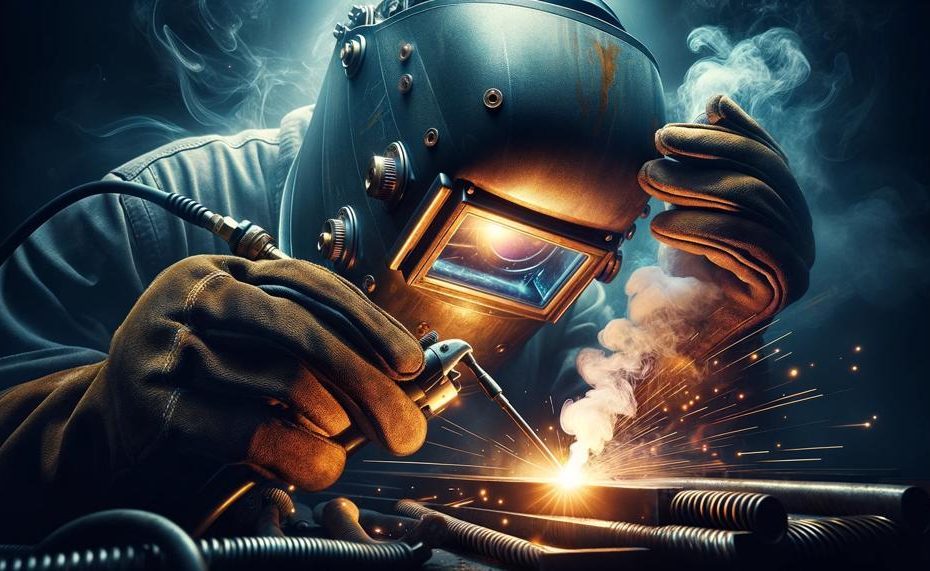Are you ready to take your TIG welding skills to the next level? Today, we’re delving into the world of gas in TIG welding. This often overlooked aspect is vital for achieving flawless welds. So, What Gas Do You Use For TIG Welding?
Argon is the most common gas used for TIG welding. It’s versatile and can be used on many metals, including mild steel, stainless steel, and aluminum. Argon is also the simplest gas for TIG welding stainless steels and nickel alloys.
Stay tuned as we explore more tips and tricks on how to use gas effectively for flawless TIG welds.
Contents
Types of Shielding Gases
TIG welding requires careful selection of the right shielding gas in order to achieve top-notch results.
While pure Argon is the most commonly used gas due to its versatility and ability to create a stable arc when welding various metals, Helium and Hydrogen can also be utilized to increase heat input and protect against oxidation.
| Shielding Gas | Main Uses | Benefits |
| Argon | TIG and MIG welding | Versatile, stable arc, capable of welding various metals |
| Helium | TIG and MIG welding | Increases heat input, protects against oxidation |
| Hydrogen | TIG welding | Increase heat input, safeguard against oxidation |
| Argon + Helium mixture | TIG and MIG welding | Improves efficiency and penetration compared to pure Argon |
| Argon + Hydrogen mixture | TIG welding | Increase heat input and prevent oxidation for thicker metals |
In addition to these gases, a mix of Argon and Helium can also be utilized for both TIG and MIG welding to enhance efficiency and penetration. Similarly, adding a small amount of Hydrogen to Argon can increase heat input and protect against oxidation when working with thicker metals.
TIG Welding Shielding Gas Blend Options
TIG welding is a highly versatile welding technique that requires the use of an inert gas to safeguard the weld pool from any atmospheric contamination. The selection of shielding gas blend plays a pivotal role in determining the quality and characteristics of the weld produced.
Let’s take a closer look at the various shielding gas blend options available for TIG welding and how they impact the welding process.
Pure Argon (Ar)
Pure argon is the most commonly used shielding gas for TIG welding. It provides a stable and narrow welding arc, exceptional arc ignition, relatively low heat input and penetration.
These features make it suitable for welding thin materials and achieving precise control over the weld pool. Pure argon also aids in minimalizing spatter and reducing post-weld cleaning.
Pure Helium (He)
Pure helium is another popular choice for TIG welding, especially for thicker materials. It has a higher ionization potential compared to argon, resulting in a hotter arc with deeper penetration.
This makes it ideal for welding thicker materials and achieving greater heat input. However, pure helium can be more expensive than argon and can lead to increased weld defects if not handled properly.
Argon-Helium Blend
A blend of argon and helium offers the advantages of both gases, making it a popular choice for TIG welding. The percentage of each gas in the blend can be adjusted to suit specific welding requirements.
A higher percentage of helium results in a hotter arc with deeper penetration, while a higher percentage of argon provides better arc stability and control.
Other Gas Additions
While argon and helium are the main gases used for TIG welding, other gases such as hydrogen, nitrogen, oxygen, and carbon dioxide may also be added in small amounts. These gases can help increase heat input and protect against oxidation. However, they should be used with caution as adding too much can impair the quality of the weld.
Pros and Cons GAS for TIG Welding
When it comes to welding, there are various methods to choose from, each with its own set of advantages and disadvantages. However, one method that stands out is TIG welding. This welding technique offers a lot of benefits that make it a top choice for professionals.
But like any other welding method, it also has its drawbacks.
Pros:
- Precise and High-Quality Outcomes: TIG welding is known for its precision and high-quality results. This makes it an ideal choice for tasks that require accuracy and neatness.
- Cleaner Process with Less Environmental Impact: Compared to other welding methods, TIG welding produces fewer fumes and smoke, making it a more environmentally-friendly option.
- Flexibility and Versatility in Various Positions: TIG welding can be used in different positions, giving welders more flexibility to work on projects that require intricate details.
- Control Over Amperage and Heat for Precise Results: With TIG welding, welders have full control over the amperage and heat, ensuring precise results every time.
- Can be Used on a Wide Range of Metals and Alloys: TIG welding is versatile and can be used on various metals and alloys, making it a popular choice among professionals.
- Only One Shielding Gas (Argon) Needed for All Metal Types and Thicknesses: Unlike other welding methods that require different gases for different metals, TIG welding only needs one shielding gas – argon. This reduces costs and makes the process more efficient.
Cons:
- Slower Process and More Expensive: TIG welding is a slower process compared to other methods, which can make it more expensive in terms of labor costs.
- Contamination Issues if Gas Coverage is Poor: If the gas coverage is not adequate during TIG welding, it can result in contamination and affect the quality of the weld.
- Need to Remember Correct Polarity for Different Metals: TIG welding requires specific techniques and skills, including remembering the correct polarity for different metals. This can be a challenge for beginners.
- Different Quality Standards for Filler Rods from Different Manufacturers: The quality of filler rods can vary from manufacturer to manufacturer, making it important to choose a reliable brand to ensure consistent results.
- Craters Can Form at the End of a Weld, Causing Additional Work: If not done correctly, TIG welding can leave craters at the end of the weld, which can require additional work to fix.
- Overheating and Discoloration Can Occur on Certain Metals: Some metals are more prone to overheating and discoloration during TIG welding, which can affect the appearance and strength of the weld.
Overall, TIG welding offers a lot of benefits and is a popular choice among professionals. However, it also requires specific skills and techniques and can be more expensive compared to other methods.
Which Shielding Gas for What Metal?
When it comes to TIG welding on stainless steel, argon is the recommended shielding gas. This gas provides a stable welding arc and is suitable for all grades of stainless steel, while also preventing oxidation and offering good penetration and bead appearance.
However, there are other gases that can be used for TIG welding stainless steel, such as hydrogen or a mix of hydrogen and argon. While these gases can increase heat input and penetrate more deeply into the metal, they also come with the risk of hydrogen embrittlement.
But argon isn’t just a suitable choice for TIG welding stainless steel; it can also be used for other metals like mild steel, aluminum, and magnesium. This versatile gas is widely available and relatively affordable, making it a popular choice among welders.
It’s important to note that selecting the correct shielding gas is crucial for achieving high-quality welds in TIG welding. The right gas will protect the weld from atmospheric contamination and produce a clean, smooth weld with strong fusion.
It’s also essential to properly set up and adjust the flow rate of the shielding gas to ensure adequate coverage during welding. Consulting with a welding expert or referring to equipment manuals can provide specific recommendations for flow rates based on the type of shielding gas being used.
| Metal | Recommended Shielding Gas | Benefits |
| Stainless Steel | Argon | Provides stable arc, suitable for all grades, prevents oxidation and offers good penetration and appearance |
| Mild Steel, Aluminum, Magnesium | Argon | Widely available, relatively affordable, versatile for various metals |
| Stainless Steel | Hydrogen or mix of Hydrogen-Argon | Increases heat input and penetration into metal, but may increase risk of hydrogen embrittlement |
To summarize, the proper selection of shielding gas is crucial in achieving high-quality TIG welds. For stainless steel, argon is the recommended choice due to its stability and versatility. However, other gases like hydrogen can also be used depending on the desired outcome. Proper setup and flow rate adjustment are also essential factors in achieving successful TIG welds.
Budget Considerations
TIG welding is a widely used welding method for its precision and clean results. However, the use of shielding gas can make it an expensive option.
Here are some budget considerations to help you save money on gas without compromising the quality of your TIG welding projects.
- Opt for smaller filler wire: Using a smaller diameter filler wire can greatly reduce the amount of gas needed for shielding. This not only results in cost savings but also offers better control over heat input and ultimately improves weld quality.
- Adjust gas flow rate: The thickness of the metal being welded can affect the required gas flow rate. By adjusting the flow rate accordingly, you can achieve efficient shielding while minimizing gas wastage.
- Lower voltage setting: Lowering the voltage setting also helps in reducing gas consumption as it requires less energy for welding, thus using less gas for cooling.
- Keep nozzle clean: Regularly cleaning the nozzle of your TIG torch is crucial to ensure optimal shielding with minimal gas usage. Make sure to remove any debris or build-up that may affect gas coverage.
- Choose high-quality gas mix: Investing in a high-quality gas mix with a higher percentage of argon can improve weld quality and reduce spatter, leading to cost savings in the long run.
- Minimize starts and stops: Frequent starting and stopping while welding can result in wastage of gas. To avoid this, plan out your welds beforehand and try to minimize excessive starts and stops.
- Consider pulse welding techniques: Pulse welding uses short bursts of energy instead of continuous current, which can significantly decrease gas consumption while maintaining weld quality.
- Regularly maintain equipment: Proper maintenance of your TIG welding equipment is essential for efficient gas usage. Check for any leaks or issues that may be causing excessive gas consumption.
- Practice proper technique: Lastly, practicing proper technique and avoiding excessive weaving or overlapping in your welds can reduce gas usage without compromising on quality.
By following these budget considerations, you can save money on gas while still achieving high-quality results in your TIG welding projects. These simple yet effective strategies can help you achieve cost savings without sacrificing the precision and clean results that TIG welding is known for.
Pros and Cons GAS for TIG Welding
TIG welding requires the use of gas to shield the weld and prevent contamination. This shielding gas, commonly argon, is responsible for creating precise and clean welds.
Despite its advantages, there are also some drawbacks when using gas for TIG welding in comparison to other welding methods.
Benefits:
- Accuracy and Quality: TIG welding is renowned for its precision and producing high-quality welds. The use of gas results in a cleaner process with minimal environmental impact, resulting in visually appealing welds.
- Versatility: TIG welding can be used on various metals and alloys, making it a versatile choice for different projects. It also allows for welding in different positions, including overhead and awkward angles.
- Control: With TIG welding, one can have precise control over the amperage and heat produced, resulting in better control over the weld and reducing the risk of overheating or creating craters.
- Cost-Effective: TIG welding may seem expensive due to its slower process and use of filler rods. However, it only requires one type of shielding gas (argon), making it more cost-effective in the long run.
Drawbacks:

- Expensive: As mentioned earlier, TIG welding can be more expensive due to its slower process and use of filler rods.
- Contamination: Poor gas coverage can lead to contamination issues in the weld, resulting in weak or faulty joints.
- Polarity: Remembering the correct polarity for different metals is crucial for TIG welding, which can be challenging for beginners or those not familiar with the process.
- Inconsistent Results: Different manufacturers may have varying qualities of filler rods, leading to inconsistent results and potentially wasting time and materials.
- Difficulty in Cutting: TIG welded work can be challenging to cut without professional assistance due to its strong and precise welds. This may be a drawback if you need to remove any welded pieces or make adjustments to the project.
Which Shielding Gas for What Metal?
When it comes to choosing the right shielding gas for TIG welding, there are a variety of factors that must be carefully considered. These factors include the type of metal being welded, the thickness of the metal, the welding environment, and the cost and availability of various gases. Each of these elements can have a significant impact on the overall quality and effectiveness of the welding process.
For instance, the type of metal being welded will determine which shielding gas is most suitable. While some metals may require a more reactive gas, others may do better with an inert gas. Additionally, the thickness of the metal being welded must be taken into account as it can affect the amount and type of shielding gas needed.
Moreover, the welding environment plays a crucial role in selecting the appropriate shielding gas. In a workshop setting, where ventilation is limited, certain gases may not be safe to use. It is important to consider the safety and health hazards associated with each gas before making a decision.
Of course, cost and availability are also key factors to consider. Some gases may be more expensive or harder to come by than others, making them less practical for everyday use. It’s essential to weigh these costs against the benefits of each gas to determine which option is best for your specific needs.
Ultimately, finding the right shielding gas for TIG welding requires careful analysis and consideration of multiple factors.
Budget Considerations
When it comes to joining metals, TIG welding is a popular choice due to its precise and clean finish. However, one crucial consideration is the cost of gas used in the process. Fortunately, there are budget-friendly options available that can still produce high-quality welds.
- Argon: This gas is the go-to for TIG welding, thanks to its affordability and effectiveness. It creates a protective barrier around the weld pool, preventing oxidation and nitrogen absorption while maintaining consistent and stable arcs.
- Helium: While pure helium may be more expensive than argon, it has a higher heat input, making it ideal for welding thicker or highly conductive materials. It can also be blended with argon to create a more cost-effective option.
- Argon-helium mixtures: Combining argon and helium offers the best of both gases and is suitable for various applications. The most common ratios are 75/25, 50/50, and 80/20 (argon/helium).
- CO2: As a more budget-friendly option, carbon dioxide can also be used as a shielding gas for TIG welding. However, it may not be as effective as argon or helium and could result in lower quality welds.
- Gas blends: Some suppliers offer pre-mixed gas blends tailored to specific welding applications, providing cost savings compared to purchasing individual gases separately. However, these options may not offer the same level of customization and may vary in quality and effectiveness depending on the supplier and mix composition.
Conclusion
In conclusion, the type of gas used in TIG welding is crucial for achieving flawless and strong welds. The gas acts as a protective barrier around the weld pool, preventing contamination and ensuring optimal results.
While argon is the most commonly used shielding gas due to its inert properties and versatility, other options such as helium or mixtures of argon and helium can also be utilized depending on the specific application.
When it comes to TIG welding on stainless steel, argon remains the top choice due to its stability and affordability. However, with proper setup and adjustment, alternative gases like hydrogen can also be used to achieve specific outcomes. To save money on gas without compromising quality, there are several budget considerations that welders can implement.
These include using smaller filler wire, adjusting gas flow rate, maintaining a clean nozzle, choosing high-quality gas mixtures, minimizing starts and stops, and exploring pulse welding techniques.
By recognizing the significance of gas in TIG welding and implementing these cost-saving measures, welders can elevate their skills while achieving significant savings.





